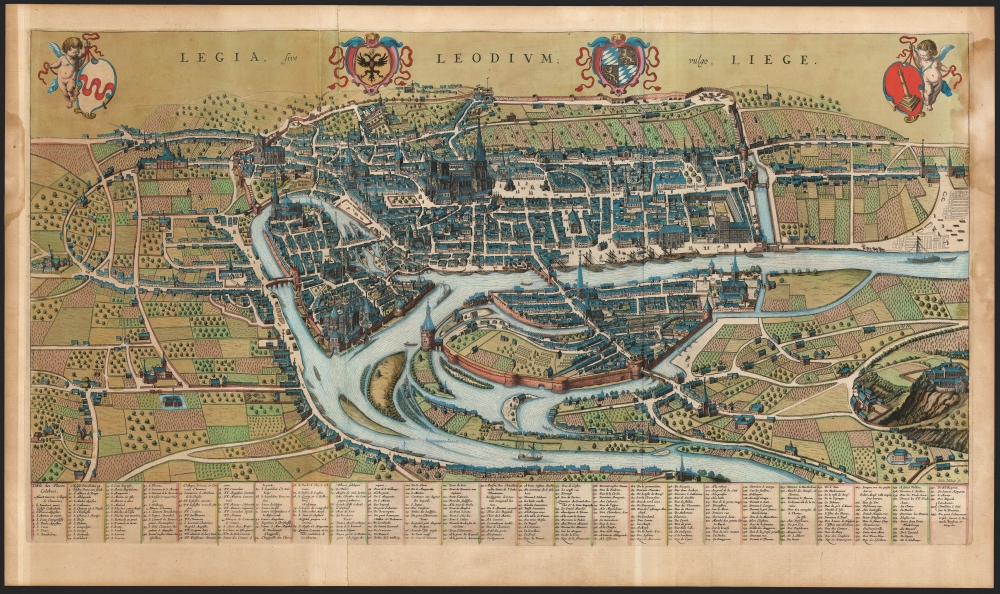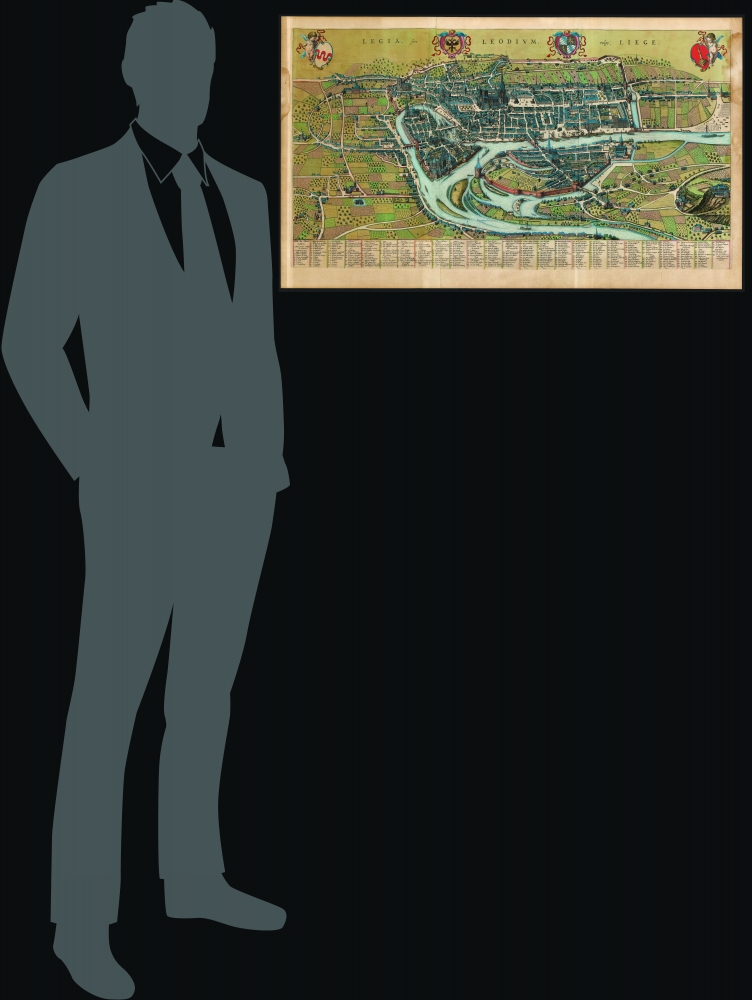1649 Blaeu Bird's Eye View of Liege, Belgium
Liege-blaeu-1649
Title
1649 (undated) 17.25 x 31.5 in (43.815 x 80.01 cm)
Description
A Closer Look
A numbered key to 250 locations appears in a table at the bottom of the engraving. Four coats of arms surmount the view: those of the Prince-Bishop of Liege, the Holy Roman Empire, Liege's Archbishop Maximilian Henry of Bavaria, and the city of Liege itself. Dominating the center of the view (and receiving the honor of number 1 in the list) is the Grand Cathedral of Our Lady and St. Lambert. When French Revolutionary forces captured the city in 1794, the French Revolutionary Army destroyed the Cathedral as an aristocratic symbol of the prince-bishop.One prominent feature of the city's topography is a sharp oxbow on the Meuse, La Sauvenière. By the end of the 18th century, La Sauvenière had become stagnant and unsanitary. Starting in 1808, the canal was gradually filled - predominantly with debris from the Cathedral of Our Lady and St. Lambert. It was turned into a canal and a promenade beginning in the 1820s, and in 1844, it was entirely filled. Today, it has been paved over by the Boulevard de la Sauvenière, otherwise known as the N617a.
Publication History
This map was engraved by Julius Milheuser for inclusion in Joan Blaeu's Novum ac Magnum Theatrum Urbium Belgicae Regiae, first appearing in the 1649 Latin edition of the book (as is the case with this example). A later state, with De Wit's imprint, has been recorded. Three separate examples are listed in OCLC. Scarce on the market.CartographerS
Joan (Johannes) Blaeu (September 23, 1596 - December 21, 1673) was a Dutch cartographer active in the 17th century. Joan was the son of Willem Janszoon Blaeu, founder of the Blaeu firm. Like his father Willem, Johannes was born in Alkmaar, North Holland. He studied Law, attaining a doctorate, before moving to Amsterdam to join the family mapmaking business. In 1633, Willem arranged for Johannes to take over Hessel Gerritsz's position as the official chartmaker of the Dutch East India Company, although little is known of his work for that organization, which was by contract and oath secretive. What is known is his work supplying the fabulously wealthy VOC with charts was exceedingly profitable. Where other cartographers often fell into financial ruin, the Blaeu firm thrived. It was most likely those profits that allowed the firm to publish the Theatrum Orbis Terrarum, sive, Atlas Novus, their most significant and best-known publication. When Willem Blaeu died in 1638, Johannes, along with his brother Cornelius Blaeu (1616 - 1648) took over the management of the Blaeu firm. In 1662, Joan and Cornelius produced a vastly expanded and updated work, the Atlas Maior, whose handful of editions ranged from 9 to an astonishing 12 volumes. Under the brothers' capable management, the firm continued to prosper until the 1672 Great Amsterdam Fire destroyed their offices and most of their printing plates. Johannes Blaeu, witnessing the destruction of his life's work, died in despondence the following year. He is buried in the Dutch Reformist cemetery of Westerkerk. Johannes Blaeu was survived by his son, also Johannes but commonly called Joan II, who inherited the family's VOC contract, for whom he compiled maps until 1712. More by this mapmaker...
Julius Milheuser (c. 1611 - 1680) was a Dutch engraver. He is known only through examples of his work on several of the large printed city plans and views appearing in Joan Blaeu's town books; he is known to have engraved the views of Liege, Schoonhoven, and Venice for Blaeu. This latter would not be printed until its publication by Mortier in 1704, the production of Blaeu's town book for Italy having been curtailed by the fire that ended the firm's operation. Learn More...




